Theft is on the rise, which is why so many businesses have placed a heavier focus on finding and preventing theft. While many companies have an active employee theft program in place, it is important to also consider all the different types of external theft.
In this article, we give you 9 ways to reduce external theft in your business. For 13 ways to prevent employee theft, take a look at the companion article.
See how Solink completes your loss prevention system to reduce external theft.
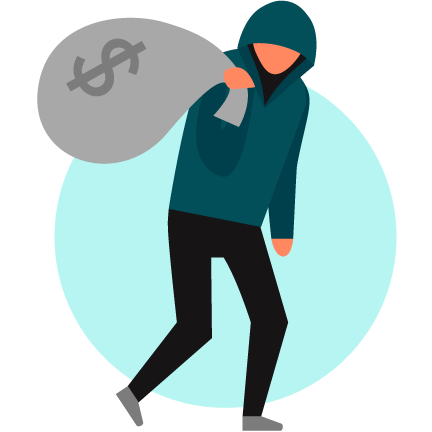
Internal theft vs. external theft
Theft can be divided into internal theft and external theft. Internal theft is where employees steal from work, while external theft is where other people steal from your company. Some estimates state about 90% of major theft losses are internal theft, so it is no wonder that most companies focus on employee theft.
However, internal and external theft are both major drivers of loss. In fact, In 2020, there were an estimated 400 million shoplifting events in America totalling $20 billion in lost revenue.
Sometimes the line between internal and external theft is blurred. For example, if your employee is helping friends commit return frauds, is that internal or external theft? Generally, if there is an inside person, it is considered internal theft regardless of who else is involved in the crime.
To reduce shrinkage as much as possible, your loss prevention system needs to cover both internal and external theft.
What is external theft?
External theft is when someone outside of an organization steals from the organization. There are many different types of external theft. Here is a simple definition of external theft:
Types of external theft
The following are some common external theft examples:
- Fraudulent product returns
- Shoplifting
- Break-ins
- Dine and dash
Another way of breaking down external theft is to consider lone actors vs. organized retail crime (ORC). The traditional image of external theft is one to three individuals shoplifting. They usually take a low number of items and the total value is also low.
However, recent trends are pointing towards the increasing relevance of ORC. These are coordinated attacks by criminal organizations with the intent to steal and resell several thousands of dollars in inventory per event.
ORC raids are a major reason some loss prevention professionals are focusing as much on external as internal theft recently.
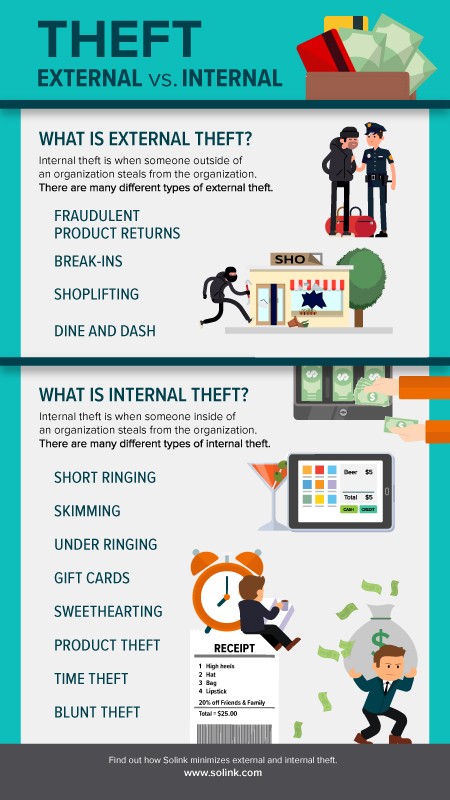
External theft examples
Here are two simple examples of shoplifting to help understand the difference between amateur shoplifters and professional shoplifters.
- Amateur shoplifter: Two high school students walk into a clothing store. One person begins a conversation with the staff member on the floor. The other puts a t-shirt into their bag and walks out.
- ORC theft: A truck pulls up to the loading dock of a big box retailer. Someone breaks into the building and opens the loading bay door. Several people jump out of the truck and begin grabbing as many boxes of inventory as possible. After a few minutes, the truck drives away.
While a business may experience dozens of amateur shoplifting events for each ORC raid, the organized theft may cost them more than all of the individual shoplifters combined.
Find what you’re looking for in seconds
Save hours sifting through video to find what your looking for in seconds with motion search in our self-guided tour.
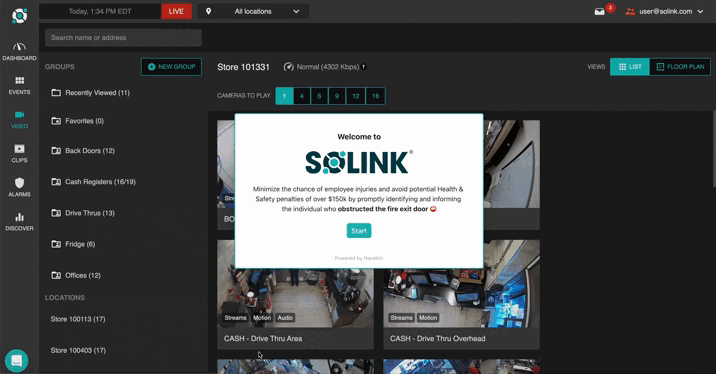
What is internal theft?
Internal theft is when someone inside of an organization steals from the organization. There are many different types of internal theft. Here is a simple definition of internal theft:
Types of internal theft
The following are some examples of internal theft:
- Skimming
- Under ringing
- Sweethearting (also known as discount abuse)
- Product theft
- Blunt theft
- Time theft
- Short ring
- Gift card fraud
Notice that many of these kinds of theft revolve around the point of sale (POS). Connecting your POS to video can help prevent many of these types of internal theft.
9 ways you can reduce external theft today
How do you prevent external theft? The following are some of the ways that you can improve the defenses of your business against external theft today:
- Implement a loss prevention system.
- Get the most out of your video security.
- Test your alarm systems.
- Lock down your safe.
- Provide excellent customer service.
- Improve the visibility of your premises.
- Keep your business clean.
- Inform staff of security measures.
- Partner with the police.
1. Implement a loss prevention system
Modern loss prevention systems are constantly evolving. While LP personnel will always be the cornerstone of effective loss prevention management, the tools they use change. It’s important to understand how everything works (and works together) so you get the most out of the security measures you have in place.

2. Get the most out of your video security
Most businesses already have security cameras installed. However, they won’t provide as much security if they aren’t part of a complete business security camera system. For example, it is unlikely that your LP personnel have the time to manually search through hours of video footage to find instances of theft.
In addition, external theft can happen during or outside of business hours. Remote video monitoring can help you see what is happening in your business from home.
Find what you’re looking for in seconds
Save hours sifting through video to find what your looking for in seconds with motion search in our self-guided tour.

3. Test your alarms system
You probably test your fire extinguishers, smoke detectors, and other important safety equipment regularly. It’s important to do the same with your security measures including alarm systems. You want to make sure that they are working properly, and that you know how they work.
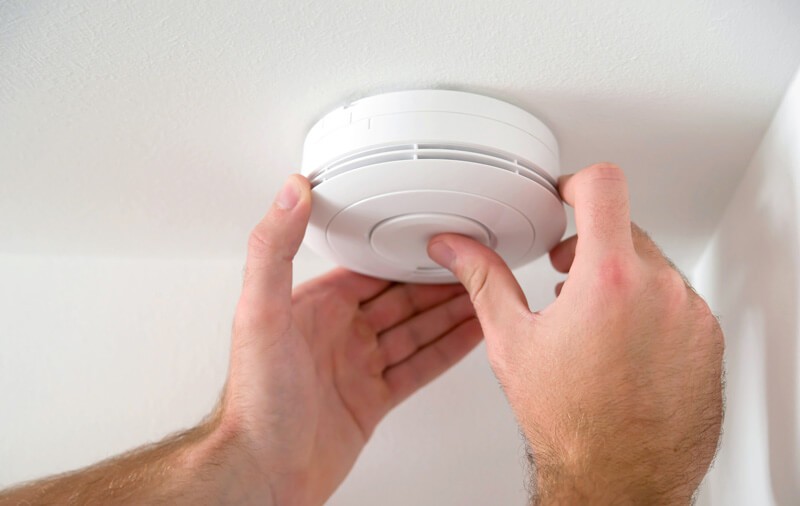
4. Lock down your safe
There are many ways to improve the security of your safe. As the move towards cashless transactions continues, one way to discourage major thefts is to maintain a lower physical cash level in your business. Here are some suggestions for keeping your safe secure from external theft:
- Minimize the amount of excess cash on hand with efficient and discreet armored car pickups. If your cash is deposited at a bank, ensure that schedule is regular and that your staff sticks to it.
- Keep an eye on the amount of cash going in and out of registers and how much is traveling to and from the safe in the back room.
- Make sure the backroom safe is properly organized and that all staff are aware of proper procedures.
- Invest in smart safes that connect directly to the POS and integrate with Solink.
5. Provide excellent customer service
This is one of the most popular pieces of advice online for reducing external theft. It is simple, low cost, and should impact your bottom line with higher revenue as well. While ORC attacks might not be deterred by employees engaging with customers, lone shoplifters are less likely to steal when they know staff is nearby.
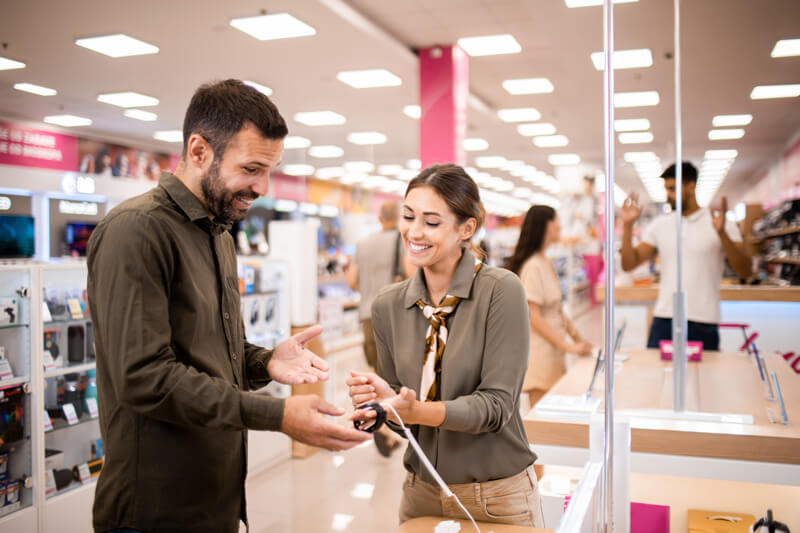
6. Improve the visibility of your premises
Visibility is an often overlooked low-tech way to improve building security. Keeping windows clean and clear of obstructions gives several advantages. High visibility of a location from outside is a theft deterrent. This is especially true of cash register visibility.
Even something as simple as keeping the windows clean creates the impression of a well-tended location which is likely to have better security features.
This leads to the next point.
7. Keep your business clean
It is much harder to conceal the theft of a sweater if the sweater display is clean with everything folded. It’s also much more enticing to potential customers if a store is clean.
For a restaurant, it is much easier for a table to dine and dash if the place is disorganized and procedures aren’t followed. Similarly, not many people want to eat in a messy restaurant.
8. Inform staff of security measures
Most companies have some loss prevention training as part of onboarding. This is usually framed around internal theft. Companies want staff to see that they will discover employee theft when it occurs and that they will take it seriously.
However, framing loss prevention onboarding around external theft can be just as effective at reducing internal theft while bringing all staff into the effort to prevent external theft.

9. Partner with the police
Many companies are still sending police video evidence using USB sticks. This is expensive, time-consuming, and unreliable.
Becoming a reliable partner of the police will lead to more responsive law enforcement. Solink’s Save and Share feature allows you to email clips to the police directly from the platform. When you reliably provide evidence, the police will proactively come to you when they are looking for video footage near your premises.
To see how Solink helps you partner with law enforcement against external theft, sign up for a demo today.
Find what you’re looking for in seconds
Save hours sifting through video to find what your looking for in seconds with motion search in our self-guided tour.

External theft FAQ
Here are some frequently asked questions about external theft.
What does external theft mean?
External theft means someone outside the company stole from the business.
What are examples of external theft?
Shoplifting, break-ins, and organized retail crime (ORC) are common types of external theft.
What is the best deterrent to external theft?
The best deterrent to external theft is a robust loss prevention system that includes both staff and tools such as security cameras and video analytics.
How can retailers prevent external theft
It is difficult to completely eliminate external theft, but retailers can build a strong loss prevention system based on their business security camera system to reduce external theft.
What does internal theft mean?
Internal theft is when an employee steals from their company.
What are examples of internal theft?
Employees stealing from their POS, taking merchandise home, or committing discount abuse are examples of internal theft.
Is shoplifting internal or external theft?
Shoplifting is a type of external theft.
What are internal and external theft?
Internal theft is when an employee steals from their company, while external theft is someone outside the business stealing from the company.
What is the difference between internal theft and external theft?
External theft means a person outside a business stealing from the company, whereas internal theft is when an employee steals from their company.
What are the preventive measures against theft?
The following are some good measures against theft:
- Implement a loss prevention system.
- Get the most out of your video security.
- Test your alarm systems.
- Lock down your safe.
- Provide excellent customer service.
- Improve the visibility of your premises.
- Keep your business clean.
- Inform staff of security measures.
- Partner with the police.
Solink is the best method of external theft prevention
External theft comes in two main types: amateur, lone actors and professional, organized retail crime (ORC). External theft costs businesses billions of dollars per year. Getting a handle on this source of loss requires advanced tools.
That’s where Solink comes in. By pairing different data sources, including your POS, with video, Solink improves your loss prevention strategy.
To see the positive ROI Solink provides your loss prevention team, sign up for a demo today.
Find what you’re looking for in seconds
Save hours sifting through video to find what your looking for in seconds with motion search in our self-guided tour.
